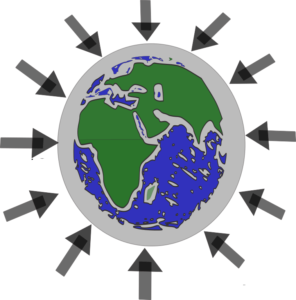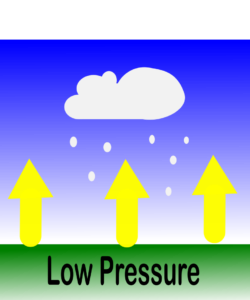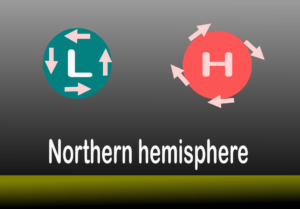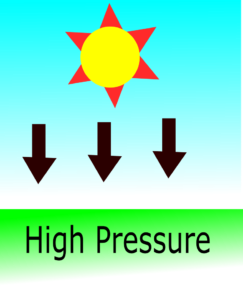Anticyclones and depressions are the yin and yang of our planet’s atmospheric drama, shaping the weather systems that influence our daily lives. These meteorological phenomena represent high-pressure and low-pressure systems, respectively, and play a pivotal role in dictating our local weather conditions and larger climate patterns. Understanding the intricacies of anticyclones and depressions is not just a matter of curiosity; it’s about unraveling the science of our atmosphere and gaining insights into the forces that govern our skies. As we embark on this exploration, we’ll delve into the formation, behavior, and consequences of these weather systems, from the serene calm of anticyclones to the stormy turbulence of depressions, all while recognizing their profound influence on global climates and our day-to-day weather experiences.
To understand the concept of depressions and anticyclones, we need to understand the terms atmospheric pressure, high pressure and low pressure.
We all know that air exerts pressure and atmospheric pressure is nothing but the force exerted by the air on the earth. To understand properly, look at the diagram given below.
Pressure is highest at sea level and decreases with an increase in altitude. Also, the earth consists of various high and low-pressure areas which control the weather around the world.
How low and high pressure is formed?
The rising of air causes low pressure. In simple terms, the rising air leads to less air on the surface means low air particle pressure. On the contrary, if the air moves down towards the surface, it means there will be more density of air particles leading to high pressure.
Easy way to remember – Taking out books from your bag (equivalent to rising of air) leads to low pressure on your shoulders while putting more books inside your bag (air towards the earth) will put high pressure on your shoulder.
Just remember that low-pressure areas create rains and storms while high-pressure area leads to clear skies.
Now that we have understood the concept of low-pressure and high-pressure areas, it is easy to understand the phenomenon of depressions and anticyclones.
Depressions
The hot air tends to rise while cold air settles down. Therefore when the hot air from the land rises, it forms the area of low pressure on the earth. This area of low pressure is called Depression.
The air moves from high pressure to low pressure hence the depression region gets more wind circulation as compared to high pressure areas. The upward and inward circulation of wind is rapid in the low-pressure region.
As the air rises from the surface and cools, it forms clouds and eventually leads to precipitation, often in the form of heavy storms. Thus, depressions are responsible for the generation of cyclones.
How does it affect the weather in the UK?
The low-pressure systems often begin in the Atlantic, moving eastwards toward the UK. These are responsible for the UK’s changeable weather. In winter they form snow storms, and in summer it cause floods and heavy rainfall.
Warm air migrating north from the tropics meets cold dense air migrating south from the polar region.
The warm air is cut by advancing cold air, and because it has more energy and lesser density than cold air, it is forced to rise above a cold front.
Further, warm air advances into the cold air and is also forced to rise above this denser cold air at the warm front.
At both fronts, air is rising to lead to cooling and condensation which eventually results in rain at both fronts.
The rising air forms low pressure at the earth’s surface at the centre of the storm. Air moves in from higher pressure areas around the depression (lower pressure area) giving the high winds that we often associate with the depressions.
The overall impact of depression
- It causes damage to the economy of the country, farming, and tourism.
- Disturbance in transportation.
- Disruption of water supply and electricity.
- Effect on farming leads to a price hike in supermarkets.
- Damage to grasslands.
- Drowning of small animals.
- Landslides
- Destruction of the habitat of wild animals.
Interesting Fact – 2007 in the UK was the wettest since records began in 1766 caused by Atlantic Depression. It leads to serious flooding in Midlands, southern England, and Yorkshire.
NOTE – The pattern of the wind direction in cyclones depends on the rotation of the earth. In the northern hemisphere in conditions of low pressure or depression, the wind moves anticlockwise while the direction of the wind is clockwise in anticyclonic (high pressure) conditions. This is due to the Coriolis force of the earth or simply due to the rotation of the earth.
Anticyclones
Anticyclones are formed in the area of high pressure. It is formed when wind sinks towards land. The sinking of air is due to the formation of a convergence zone at a higher altitude. As the air cannot move upwards, it is forced to move downwards. As the air hits the earth’s surface, it diverges in different directions. The divergence is due to the tendency of the winds to move from the high-pressure area to the low-pressure area. Due to this divergence, these winds do not carry the moisture with them to be able to form clouds. Thus, anticyclones leads to clear skies.
How do anticyclones affect the weather in the UK?
In winter, a stable atmosphere and light winds due to anticyclonic conditions can lead to fog and frost. The fall in temperature is due to the clear skies which allow the heat to be lost from the surface of the earth through radiation. Further, light winds encourage the formation of fog.
As the sea surrounds the UK, the air is often moist. The fast-cooling ground cools and condenses any moisture in the air, forming droplets of ice when the temperature falls below freezing forming frost.
In summer, anticyclones bring warm, long sunny days with them. Though anticyclones make the weather dry sometimes when the temperature gets too high, it can lead to thunderstorms. Generally, anticyclones bring warm and fine weather to the UK and nearby continents.
Anticyclones in winters can cause haze and fog interrupting clear vision and thus affecting transportation and daily activities.
Frequently Asked Questions
What are anticyclones, and how do they influence weather patterns?
Anticyclones are high-pressure systems characterized by descending air. They lead to clear skies, stable weather, and light winds.
Explain the formation of depressions and their role in bringing changing weather conditions.
Depressions are low-pressure systems characterized by ascending air. They bring cloudy skies, rain, and often strong winds.
How do anticyclones and depressions interact to create weather fronts, and what types of weather are associated with fronts?
Anticyclones and depressions meet at fronts, where warm and cold air masses collide. This collision often leads to precipitation and varied weather conditions.
Describe the significance of isobars in weather maps and how they relate to anticyclones and depressions.
Isobars are lines connecting points of equal atmospheric pressure. They help identify areas of high and low pressure, which are associated with anticyclones and depressions.
How can the movement of anticyclones and depressions impact climate and weather patterns over larger geographic regions?
The movement of these systems can influence long-term climate patterns, seasonal weather variations, and the frequency of extreme weather events.









